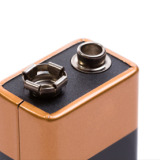9-Volt Battery Fire Hazard
9-volt batteries have been the cause of many house fires in recent years. Consumers are often unaware of the potential safety hazards associated with 9-Volt batteries. The design of 9-volt batteries makes it necessary to take certain precautions when storing and disposing of the batteries in order to mitigate fire hazards.
9-Volt Battery Design
On a 9-volt battery, the positive and negative posts are situated side by side. Due to this configuration any object or material that is conducive to electricity may form a circuit if placed over the top of the positive and negative posts. This circuit will generate heat, which may cause burns if touched or may ignite flammable materials in the vicinity.
9-Volt Battery Storage Hazards
Storing 9-volt batteries in a drawer with metal and flammable materials is a fire hazard. Other batteries, keys, paper clips, and change all have the potential to form a circuit when touching both the positive and negative posts. If this circuit comes in contact with materials such as paper or pencils, the heat may ignite the flammable materials. Since all of these materials are often stored in household “junk” drawers with 9-volt batteries, the potential fire hazard is high. The risk is further increased because the discreet nature of a drawer may cause the fire to become larger and spread to cabinets before being detected by residents.
Proper 9-Volt Battery Storage
In order to mitigate storage hazards associated with 9-volt battery storage, these batteries should be stored in the original packaging until use. 9-volt batteries should be stored away from other batteries and materials that may form a circuit or ignite. If batteries must be removed from packaging, placing a piece of electrical or masking tape over the exposed posts will prevent the batteries from coming into contact with hazardous materials.
9-Volt Battery Disposal
Disposing of 9-volt batteries in a trash receptacle with other materials also holds the potential to start a fire. Batteries may come into contact with rubbish such as aluminum foil or other batteries, and may ignite flammable cooking agents or paper rubbish that has been discarded. This is an ongoing potential hazard, as batteries that have been discarded may be moved around during the process of trash removal and transport. Fires that begin in a garbage pile may also be difficult to locate and extinguish.
Proper Disposal
9-volt batteries should not be discarded with other household rubbish. After removing 9-volt batteries for disposal, the posts should be covered with tape to ensure safety until the batteries can be properly disposed of. Some states and towns offer collections sites for hazardous household waste such as batteries. Contacting city or state officials to determine the best way to dispose of 9-volt batteries in the area is recommended.
Sources:
“9-Volt Battery Safety.” NFPA. NFPA. Web. 5 Sept. 2014. <http://www.nfpa.org/~/media/files/safety information/safety tip sheets/9voltbatterysafety.pdf>
Tomlinson, Chris. “9-Volt Battery Starts House Fire [Video] – Churubusco Volunteer Fire Department.” Churubusco Volunteer Fire Department. Churubusco Volunteer Fire Department, 1 Jan. 2014. Web. 5 Sept. 2014. <http://buscofire.org/2014/01/09/9-volt-battery-starts-house-fire/>
“Weekly Safety Wisdom- 9-Volt Batteries- a Fire Hazard.” IMLRMA. IMLRMA. Web. 5 Sept. 2014. <http://iml.org/file.cfm?key=7455>














